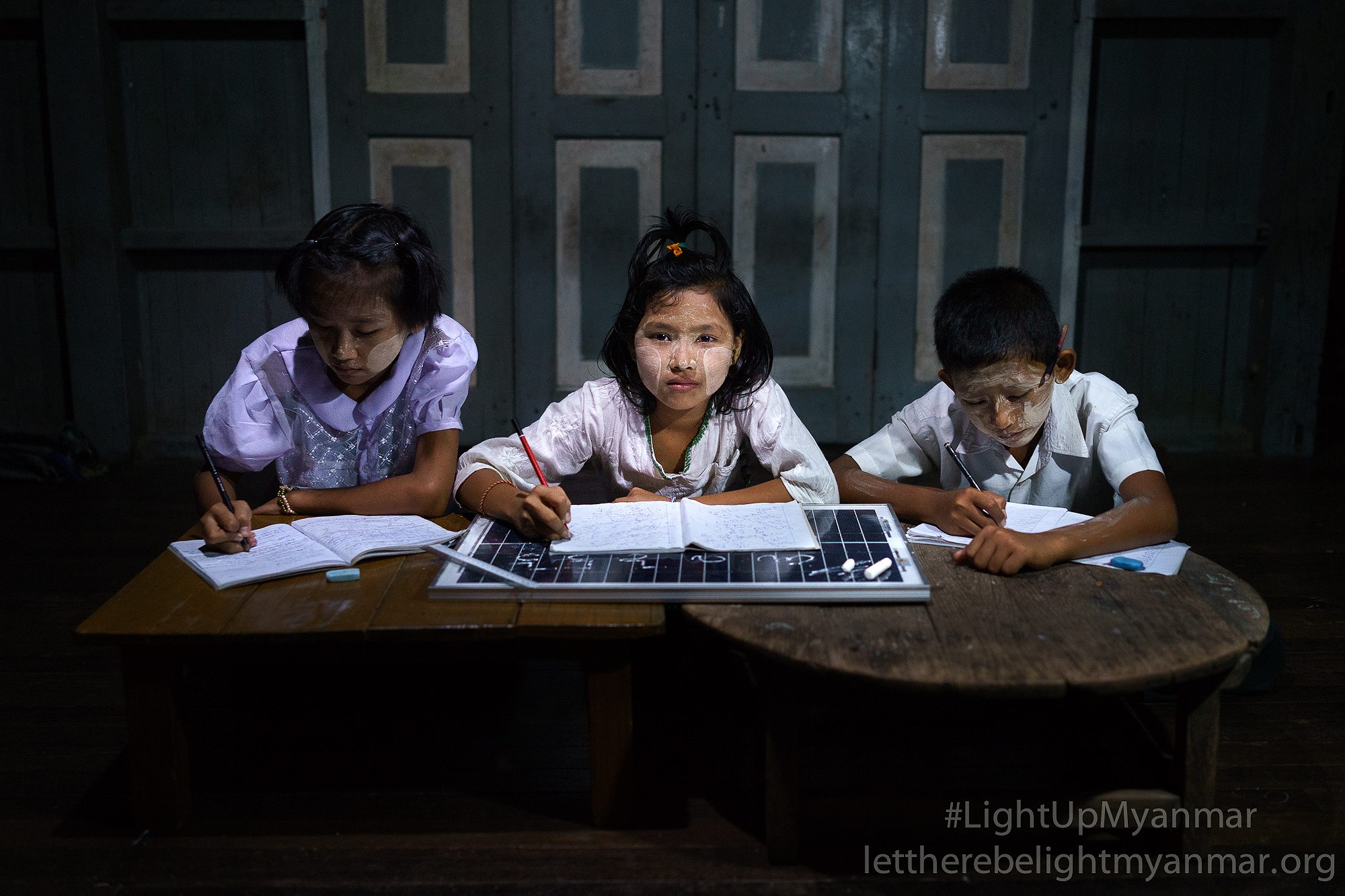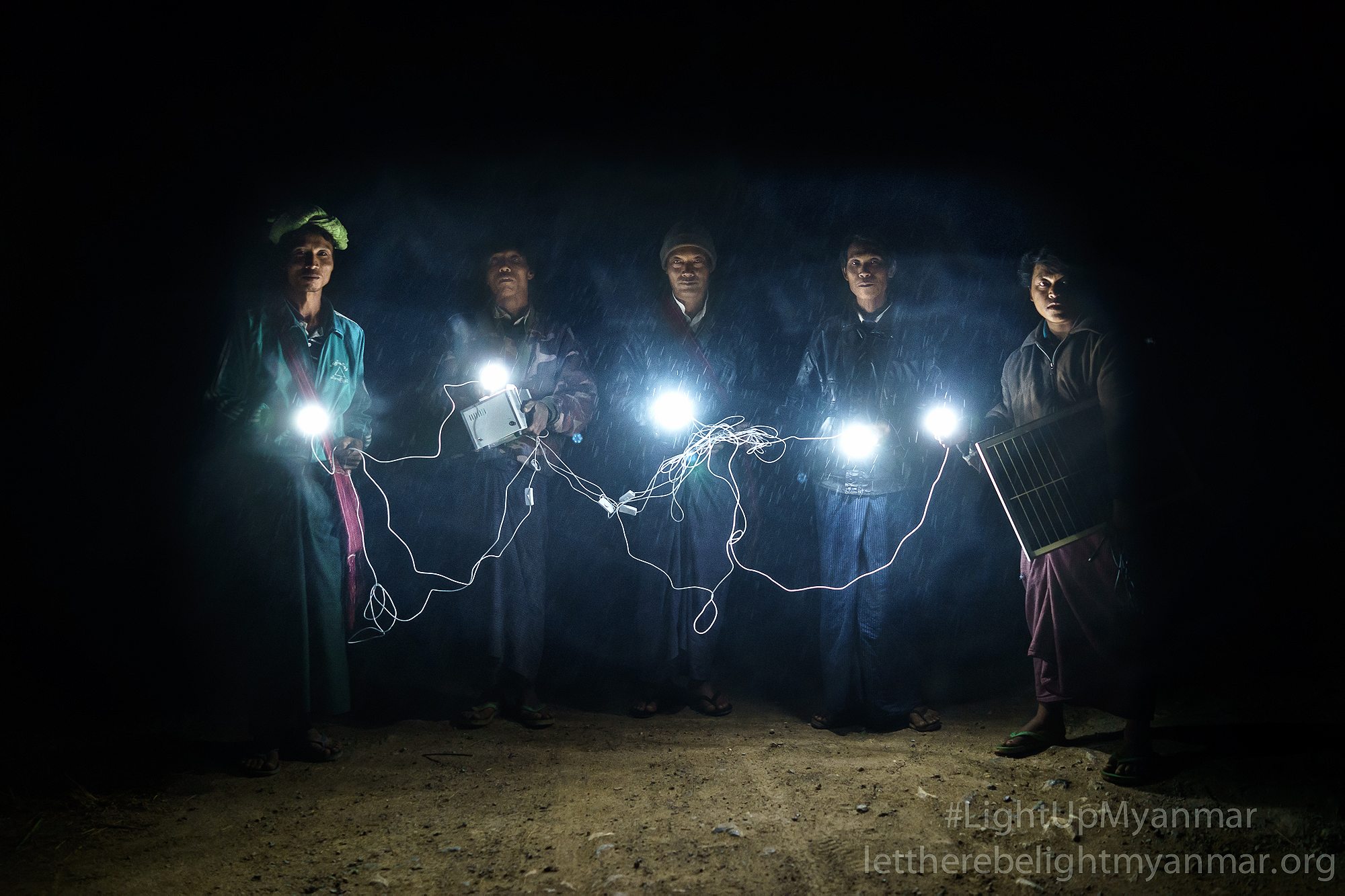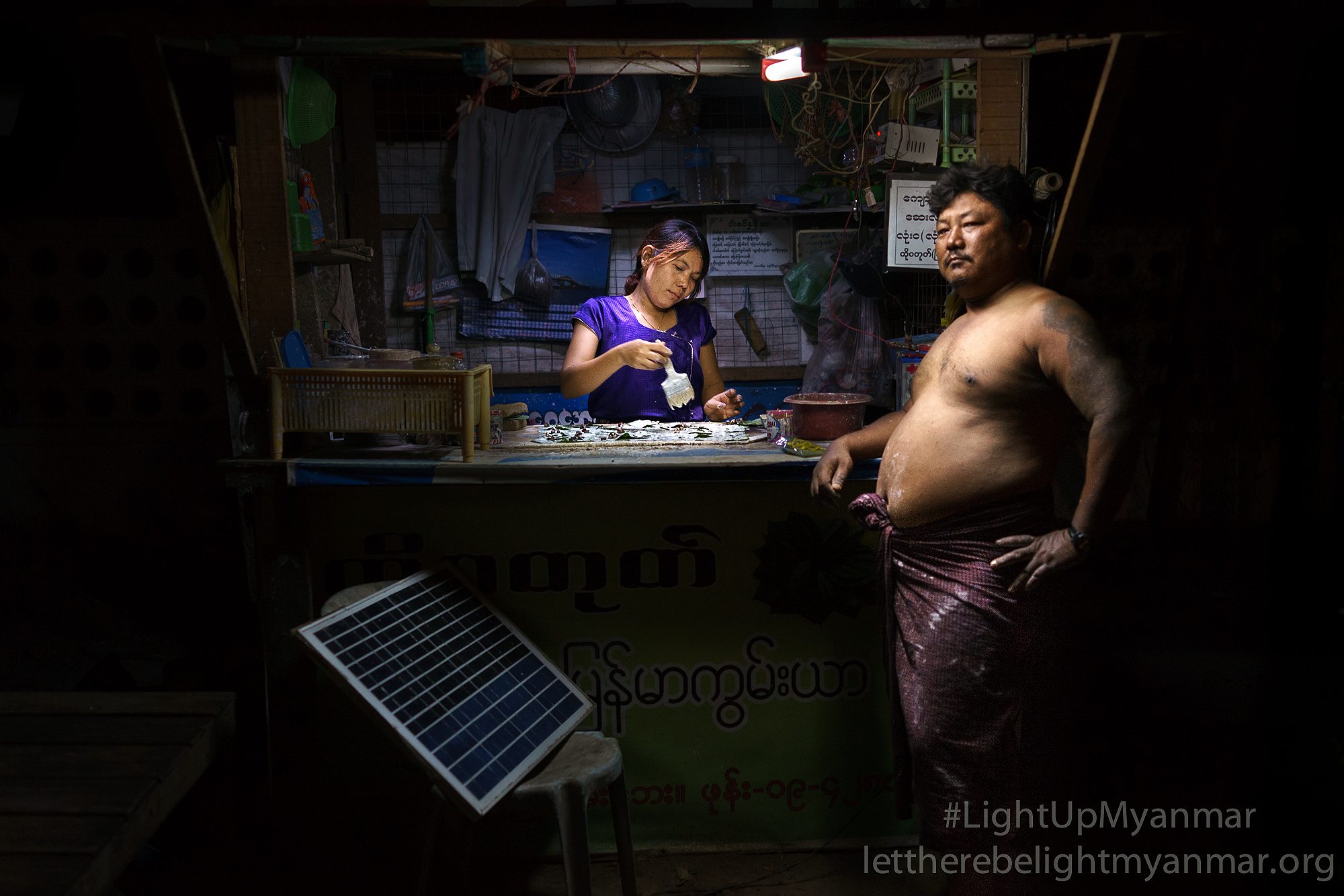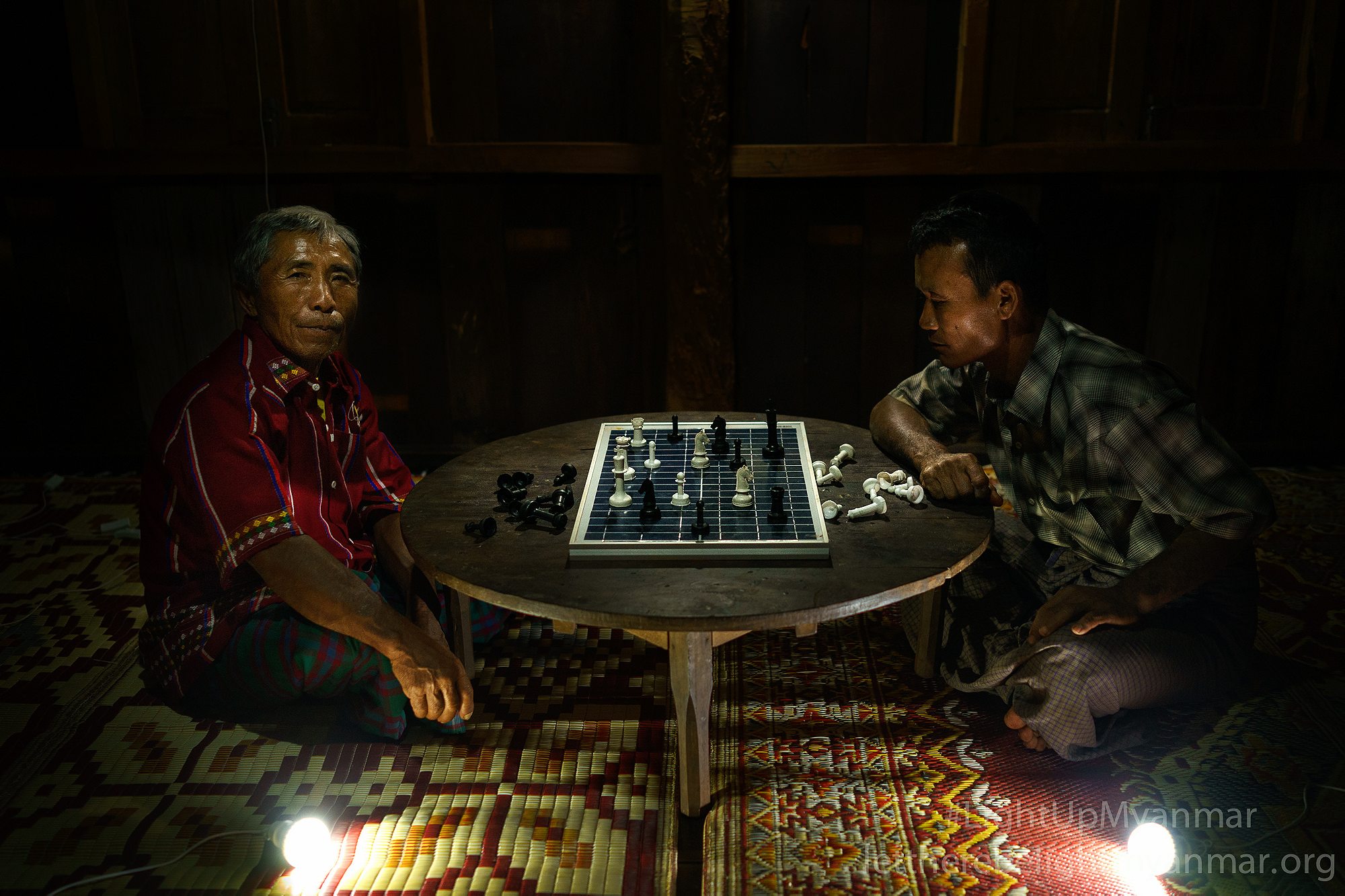In a country where just a quarter of the population has access to the electrical grid, a photographer documents the life-changing effects of solar panels.
What difference can a light bulb make? When photographer Rubén Salgado Escudero came across people using solar panel systems in rural Myanmar, he realized the potential for their lives to improve was huge. From late night Chinlone games to early morning fishing trips, he started documenting the ways that people who previously had no access to electricity were choosing to spend their newly found hours of the day. Combining imagery with practicality, he used solar bulbs himself as his only light source to shoot each photo. The resulting Solar Portraits, which won a Sony World Photography award, were so compelling that the photographer received messages from people across the world who asked how they could help. His answer was to launch the Let There Be Light Myanmar campaign, which will raise funds to purchase and distribute solar systems across Myanmar’s Dry Zone in partnership with the organization PACT. He joined R&K from India.
Roads & Kingdoms: Can you describe Myanmar’s infrastructure today in terms of electricity?
Rubén Salgado Escudero: Only about 26 percent of Myanmar’s people have access to electricity, so you can imagine how primitive that is. Outside of large cities, that can actually go up to 90 percent. This is partly due to the fact that the government hasn’t made it a priority, especially not during the military junta. It’s trying to do a little bit more now, not enough, but it does have plans to bring electricity to some areas and even hand out solar panels to about 3,000 villages. I think there are about 65,000 villages in the country so obviously that’s not too many. According to large NGOs who have read the government’s plan—and I have read the documents too—it seems quite irresponsibly planned out in terms of sustainability. The quality of the systems that they will provide is not ideal, it’s not long-lasting, and they don’t have a plan so far for maintenance programs or for education, to teach people how to use these solar systems. So the government is really not doing enough and the people are pretty much living in the dark.

R&K: What do people do use without access to the grid?
Salgado Escudero: They use candles, which are dangerous because most people live in huts. They are also quite expensive and the smoke fumes are toxic. They also use flashlights, but batteries are very expensive for the average Burmese person. This is basically how people live, I mean after the sun goes down people turn on flashlights, light candles and do the best they can to live day by day with that. For a child who wants to read or study, that’s very damaging to the eyes and very difficult. Many activities are affected obviously. Just imagine how we would live if we didn’t have electricity.

R&K: When did you first come across these solar panels?
Salgado Escudero: I first saw the solar panels when I was working for a humanitarian organization as a photographer. I traveled to various regions of the country for a month documenting infrastructure for them, nothing to do with light. A lot of the time, I stayed in the villages I was photographing and that’s where I was confronted with the fact that at night, we had no light. After about three weeks of traveling, I came across one village that lo and behold had households with solar lights that had been brought by an organization. The improvement of their quality of life was very apparent to me. This gave me the idea to talk to these people and find out how their lives had been affected by having solar light for the very first time, by having any light at all actually.

R&K: Lack of access to electricity is just one of the many problems tied to the junta’s control of Myanmar’s natural resources for so long. Can you talk about how they used natural resources to their gain?
Salgado Escudero: Natural gas is being exported, there’s a lot of legal and illegal timber logging and trading between China and Myanmar. Jade, rubies, all sorts of different minerals that Myanmar has are being sold and exported, but the only people that are really benefiting from this are government officials, or people who have made pacts with the government, what they call “cronies” in Myanmar. These people work closely with the government for their personal gain and they become millionaires while the rest of the population stays under a very, very low poverty line. Myanmar is the poorest country in Asia and wouldn’t need to be at all because it’s very rich in many natural resources. It even used to be the second largest exporter of rice in the world, but that all ended when the junta took over.

R&K: How do solar panels change people’s lives concretely?
Salgado Escudero: I talked for example to a fisherman who, ever since he has solar light, can set up his boat an hour earlier in the morning. It gives him more time to grab fish every day for his family and to sell, so this is a large livelihood improvement. Children, students in small schools with after school programs that now have lights can read and do their homework. Same at home. A huge number of children, more than 70 percent, are born through labor assisted by midwives in villages. These women are very important to society. Thanks to solar lights, midwives can more easily bring children into the world. And then you have everyday improvements, like people can play chess, they can tell each other stories and look each other in the eye, they can eat, they can cook, these are everyday things that we completely take for granted but that are large improvements to their livelihood.

R&K: How exactly were the photographs taken?
Salgado Escudero: The photos were taken using solar light as the only source of illumination. This was a strict rule that I made for the project, which made sense to me because of the subject. I had to have ideas on how to light, use different types of solar bulbs to create a scene and illuminate in the specific style that I wanted. Many times I would sketch out the painting or the photo before taking it, to get an idea of the composition, how I wanted the portrait to look. All these photos were taken in their environment and according to what people answered after I asked them how their life had improved or changed. Their answer would give me the inspiration or the idea for their portrait.

R&K: How did the project go from photography to campaign?
Salgado Escudero: The project received much visibility after I won Best Portrait at the Sony World Photography Awards and after Time magazine and GEO magazine published the photos. I received quite a lot of emails from readers who were interested and curious about what they could do to bring more solar light to Myanmar. A very keen reader from Austria wanted to create a crowdfunding project to help raise money for this cause. I found that it was a very good idea. I have this feeling that photojournalism, documentary photography, is important—this is why I do it, to bring visibility to people who maybe don’t have a voice outside of their community—however sometimes, it’s just not enough. By getting visibility for this project, by getting inspired by people who saw the work and gave me feedback, I realized that maybe there is something more that one can do. In this case, yes, why not create a platform to not only tell the world that solar light is improving the lives of people, but also to raise funds and bring more solar light to the people that don’t have it today? So it was actually quite clear that it was something that could be done. I don’t know how well it’s going to go, we’ve worked very hard to make this professional by working with an NGO that has a good reputation and is trustworthy and cares about sustainability. The hope is to raise as much money as possible. Every dollar is going to count because for $100 dollars, one can bring lights to a whole family. Our goal is $25,000 but the more funds we get and the more people collaborate with us, the more families are going to have light the day after tomorrow. So, if one can do more than just take photos and tell a story, I see it as a good opportunity. I think it’s a positive thing.

R&K: Looking at the future, do you think of solar panels as a temporary solution until the electric grid is installed? Or can they be here to stay?
Salgado Escudero: These inexpensive solar systems are temporary, at least for the moment, because they have a lifespan of three to five years. It is a remedy while the electric grid is installed, but it’s a solution that can happen overnight, is environmentally-safe and inexpensive by our standards. It’s not going to replace electricity yet, although in some European countries like Holland, the technology is evolving. For example, there are roads that are made of solar panels that cars can drive on, and that power entire towns. This is where the future is going for sure. We’re not quite there yet, but where we are is that for the first time, basic solar systems are not expensive. We have the potential to distribute them in much of the developing world to give people a chance to have light.
To donate to the campaign, please visit Let There Be Light Myanmar or follow updates here.